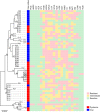Antibiotic-resistant status and pathogenic clonal complex of canine Streptococcus canis-associated deep pyoderma
- PMID: 36352470
- PMCID: PMC9644607
- DOI: 10.1186/s12917-022-03482-3
Antibiotic-resistant status and pathogenic clonal complex of canine Streptococcus canis-associated deep pyoderma
Abstract
Background: Streptococcus canis causes deep pyoderma in canines, which raises concerns about the risk of isolates from lesions acquiring an antibiotic-resistant phenotype. It is necessary to identify effective antibiotics and the characteristics of the pathogenic cluster for S. canis-associated deep pyoderma.
Results: The signalment, molecular typing, and antibiotic-resistant status of S. canis isolated from deep pyoderma lesions (27 strains) and oral cavities (26 strains) were analyzed. Older dogs tended to have S. canis-associated deep pyoderma (15 of 27 dogs over 10 years old). Veterinarians chose quinolones for 10/16 cases (63%), even though the rate of quinolone-resistant strains of S. canis is 38-59%. Although 70% of the strains showed resistance to three or more antibiotic classes (37/53), 94% (50/53) strains showed sensitivity for penicillins. We also identified β-lactamase activity among penicillin-resistant strains of S. canis. Clonal complex 13 (CC13) was detected only in lesions and formed independent clusters in the phylogenetic tree. One strain of CC13 was resistant to the anti-methicillin-resistant Staphylococcus aureus drugs, vancomycin and linezolid.
Conclusion: Although antibiotic-resistant strains of S. canis are isolated at a high rate, they can currently be treated with β-lactamase-inhibiting penicillins. CC13 may be a pathogenic cluster with high levels of antibiotics resistance.
Keywords: Antibiotic resistance; Beta-lactamase; Dogs; Multilocus sequence typing; Opportunistic infections; Oral cavity; Pyoderma; Streptococcus.
© 2022. The Author(s).
Conflict of interest statement
To our knowledge, the named authors have no conflicts of interest, financial or otherwise.
Figures


Similar articles
-
Clonal distribution of methicillin-resistant Staphylococcus pseudintermedius isolates from skin infection of dogs in Korea.Vet Microbiol. 2017 Oct;210:32-37. doi: 10.1016/j.vetmic.2017.08.017. Epub 2017 Aug 30. Vet Microbiol. 2017. PMID: 29103693
-
One health approach to genetic relatedness in SCCmec between methicillin-resistant Staphylococcus isolates from companion dogs with pyoderma and their owners.Vet Microbiol. 2021 Feb;253:108957. doi: 10.1016/j.vetmic.2020.108957. Epub 2020 Dec 13. Vet Microbiol. 2021. PMID: 33385887
-
Staphylococci isolated from cats in Italy with superficial pyoderma and allergic dermatitis: Characterisation of isolates and their resistance to antimicrobials.Vet Dermatol. 2023 Feb;34(1):14-21. doi: 10.1111/vde.13127. Epub 2022 Oct 11. Vet Dermatol. 2023. PMID: 36221849
-
Antimicrobial resistance in staphylococci in small animals.Vet Clin North Am Small Anim Pract. 2013 Jan;43(1):19-40. doi: 10.1016/j.cvsm.2012.09.003. Vet Clin North Am Small Anim Pract. 2013. PMID: 23182322 Review.
-
Strategies for management of recurrent pyoderma in dogs.Vet Clin North Am Small Anim Pract. 1990 Nov;20(6):1509-24. doi: 10.1016/s0195-5616(90)50158-8. Vet Clin North Am Small Anim Pract. 1990. PMID: 2251739 Review.
Cited by
-
Genomic analysis of Streptococcus canis from different hosts in Italy 2004-2021: diversity, antimicrobial resistance, and virulence profiles.Front Vet Sci. 2025 Aug 19;12:1645885. doi: 10.3389/fvets.2025.1645885. eCollection 2025. Front Vet Sci. 2025. PMID: 40905008 Free PMC article.
-
Two episodes of bacteremia of zoonotic origin caused by different Streptococcus canis isolates in the same patient within a time span of 1 year.Eur J Clin Microbiol Infect Dis. 2024 Feb;43(2):383-387. doi: 10.1007/s10096-023-04718-2. Epub 2023 Nov 24. Eur J Clin Microbiol Infect Dis. 2024. PMID: 37996728
-
Chromogenic culture media complements diagnostic cytology in the visual identification of pathogenic skin bacteria in dogs and cats.Front Vet Sci. 2023 Jul 11;10:1152229. doi: 10.3389/fvets.2023.1152229. eCollection 2023. Front Vet Sci. 2023. PMID: 37496749 Free PMC article.
-
Seven draft genome sequences of Streptococcus canis strains, revealing reduced penicillin-G susceptibility.Microbiol Resour Announc. 2024 Jun 11;13(6):e0021924. doi: 10.1128/mra.00219-24. Epub 2024 May 14. Microbiol Resour Announc. 2024. PMID: 38742884 Free PMC article.
References
-
- Miller WH, Griffin CE, Campbell KL, Muller GH, Scott DW. Muller & Kirk's small animal dermatology. 7. St. Louis: Elsevier; 2013.
-
- Loeffler A, Lloyd DH. What has changed in canine pyoderma? A narrative review. Vet J. 2018;235:73–82. - PubMed
-
- Galpérine T, Cazorla C, Blanchard E, Boineau F, Ragnaud J-M, Neau D. Streptococcus canis infections in humans: retrospective study of 54 patients. J Inf Secur. 2007;55(1):23–26. - PubMed
-
- Sharma B, Srivastava M, Srivastava A, Singh R. Canine streptococcal toxic shock syndrome associated with necrotizing fasciitis: an overview. Vet World. 2012;5:311–319.
MeSH terms
Substances
Supplementary concepts
Grants and funding
LinkOut - more resources
Full Text Sources
Medical
Molecular Biology Databases

